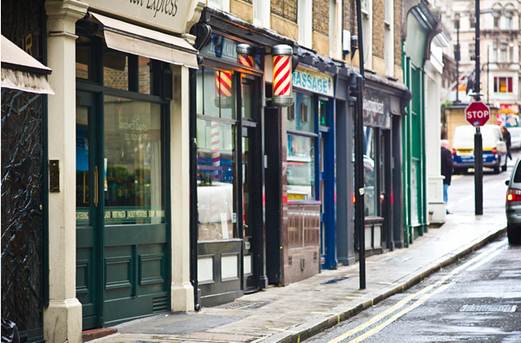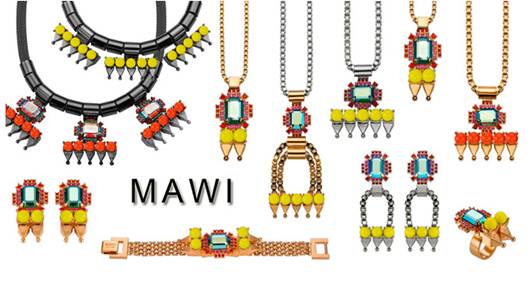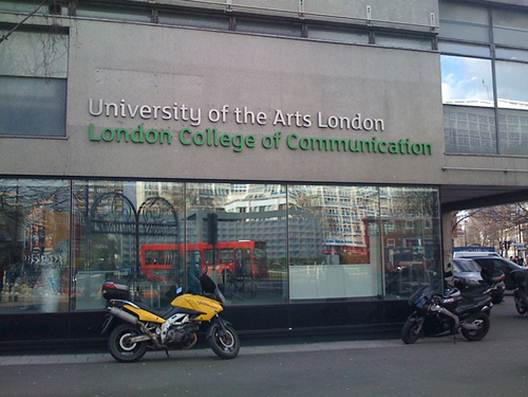
English
barber’s shop
Walk around the area and a first impression
of fading neon and dirty shop fronts may leave you wondering what the fuss is
about. But you only need to scratch the surface to find fun. Behind an unmarked
door on Great Eastern street is Lounge Bohemia, a semi-secret cocktail bar run
by a Czech mixologist, famed for such outré creations as Campari Candy Floss
and the Full English Brakfast Martini (far nicer than it sounds). The Start
boutique on Rivington Street in one of the area’s longest-standing emporia, stocking
London designers such as Chritopher Kane and Richard Nicoll. If you want to fit
in among the neighbourhood’s creatively hirsute, get yourself shorn at
Murdock’s – a distinctively modern take on the traditional English barber’s
shop, complete with badger’s hair brushes and cut-throat razors.

Mawi
Keivom, the Indian-born jewellyer designer, opened her flagship store on nearby
Calvert Avenue
Mawi Keivom, the Indian-born jewellyer
designer, opened her flagship store on nearby Calvert Avenue last year. There
is no other part of London she would have chosen. “You have this amazing
diversity of different cultures. It’s East End Barrow boy meets African high
priestess – when they play high-life music by the African textile market at
Ridly Road, it’s hard to imagine you are so near the City of London.”
Venture deeper you arrive in Dalston, a
couple of miles up Shore ditch High Street. Always a lively centre for London’s
West Indian and Turkish communities, it has now become a hipster’s paradise to
rival Manhattan’s Lower East Side, and was recently described by Italian Vogue
as the coolest place on earth. Again, it can seem unprepossessing at first
glance – but you soon notice the trend for bars to take up residence in old
shops without changing the signage. Try the Dalston Superstore – the most
reliable place for hipster – spotting, the low-fi Visions Video Bar for its
R&B nights, or the ever-rammed Jazz Bar

London College of Communication - University of the Arts
Rising rents now mean the artists who used
to have studio in the area have moved out to cheaper locales like Bow, White
chapel and Hackney Wick (home to 600 artists’ studios, the highest
concentration in Europe). But the recent arrival of the new east London Line
has opened Dalston up in other ways. It now houses one of London’s most
futuristic shops. LM-CC, a space-age warren that feels more like a museum than
a clothes store.
“Dalston is booming,” says Dan Mitchell,
LN-CC’s co-founder. “Cool stores, bars and cafés are opening up everywhere. But
at the same time, the original local communities are still doing business, as
they have for the last 60 years. The Turkish restaurants that have been here
since the 1940s are booming. It’s really great to see these contracsts of
cultures in one place. That’s the beauty of East London.”
Amid all this diversity, you’ll also find
some unexpectedly great places to stay. A mile or two south in King’s Cross is
Rough Luxe, a Grade II listed building transformed into a wonderfully eccentric
boutique hotel; in Mile End you’ll find 40WINKS, a grand Queen Anne-era
townhouse converted into a stylish home-from-home. Surely the Grandest place to
stay for the Olympic, however, is the St Pancras Renaissance London gotel. A
neo-gothic masterpiece built in the late-19th century to serve
railway passengers, it is built over St Pancras station and has now been
restored into one of London’s finest hotels. It is one part of a huge
redevelopment around the adjacent St Pancras and King’s Cross stations that is
steadily transforming what was once another downmarket stretch into an
alternative hub. This is where the high-speed train to the Olympics site
departs from. Connecting to Stratford in less than 10 minutes, it has made
King’s Cross the new gateway to East London.

the
River Lea
If you have longer to spare, make the
journey on two wheels, cycling down the Regent’s Canal, branching off to
explore the River Lea. The towpaths of London’s industrial waterways are
wonderfully tranquil, and offer an alternative view of London life. Follow the
Lea all the way to the Olympic Stadium and you might even see some authentic
Cockneys fishing for perch.
Or peel off around Broadway Market. On
Saturday mornings, traders hawk artisanal produce while muddle-headed clubbers
traipse home in last night’s clothes. If there’s a sight more likely to lift
the soul of the urban explorer, I do not know it.